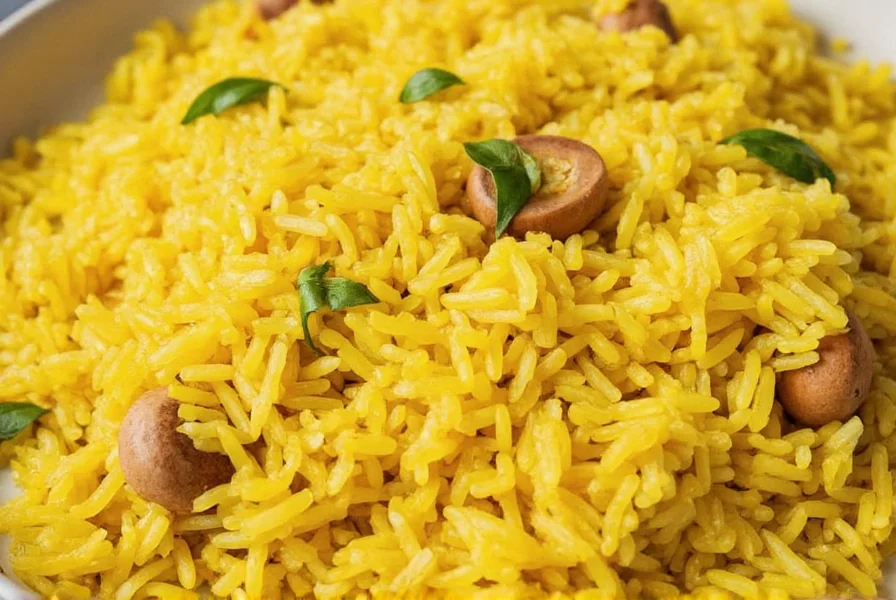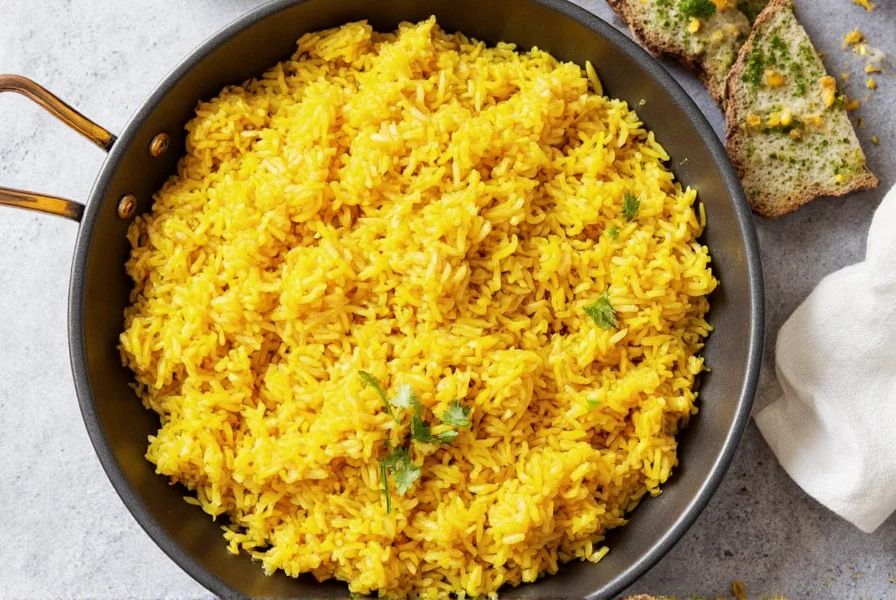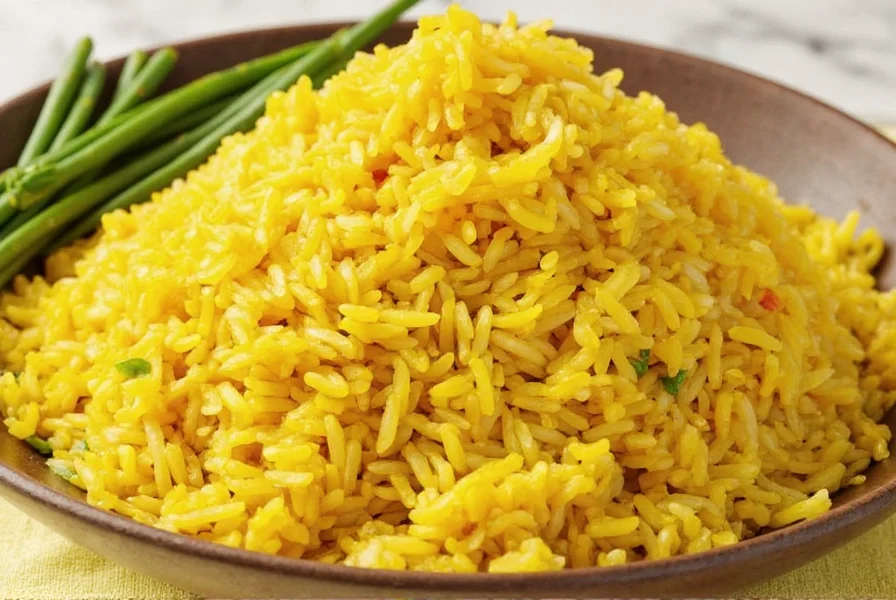Golden turmeric rice has been cherished across global cuisines for centuries, from Indian haldi chawal to Middle Eastern sholeh polo. This versatile spice not only imparts a beautiful yellow color but also contributes a warm, slightly bitter flavor that complements rice's natural neutrality. When properly prepared, turmeric rice serves as an excellent base for curries, grilled proteins, or vegetable dishes while offering the potential anti-inflammatory properties associated with curcumin, turmeric's active compound.
The Science Behind Perfect Turmeric Rice
Understanding the chemistry of turmeric helps create better rice dishes. Turmeric contains curcuminoids, which are fat-soluble compounds that bind more effectively when cooked with oil or ghee. This explains why traditional recipes often begin by blooming turmeric in fat before adding rice and liquid. The optimal temperature for curcumin extraction is between 160-180°F (70-82°C), which occurs during the initial cooking phase when liquid is added to the pot.

Basic Golden Turmeric Rice Recipe
This foundational recipe serves as the basis for countless variations. For authentic flavor development, proper rice-to-liquid ratio, and vibrant color retention, follow these professional cooking techniques:
| Ingredient | Measurement | Preparation Tip |
|---|---|---|
| Basmati rice | 1½ cups | Rinse until water runs clear to remove excess starch |
| Turmeric powder | 1½ tsp | Bloom in oil first for maximum color and flavor |
| Water or broth | 2¼ cups | Use warm liquid for even cooking |
| Ghee or oil | 1 tbsp | Traditional fat enhances turmeric absorption |
| Salt | 1 tsp | Add to liquid, not directly on rice |
Step-by-Step Preparation Method
Follow this professional technique for perfect turmeric rice with distinct grains and vibrant color:
- Rinse basmati rice thoroughly in cold water until the water runs clear (3-4 rinses)
- Soak rice in clean water for 20-30 minutes to improve texture
- Heat ghee in a heavy-bottomed pot over medium heat
- Add turmeric and toast for 30 seconds until fragrant (blooming step)
- Add drained rice and stir gently to coat each grain with turmeric-infused fat
- Pour in warm broth or water with salt already dissolved
- Bring to a gentle boil, then immediately reduce heat to lowest setting
- Cover tightly with a lid and cook undisturbed for 15 minutes
- Remove from heat and let stand covered for 10 minutes
- Fluff gently with a fork before serving
Cultural Variations of Turmeric Rice
Different culinary traditions have developed distinctive turmeric rice preparations. These authentic variations showcase how the same basic ingredients transform across regions:
- Indian Haldi Chawal: Features cumin seeds tempered in oil before adding turmeric and rice, often finished with fresh cilantro
- Persian Sholeh Polo: Incorporates turmeric with saffron, cinnamon, and barberries for special occasions
- Caribbean Curry Rice: Combines turmeric with curry powder, coconut milk, and pigeon peas
- Thai Khao Yam: Uses fresh turmeric root with rice noodles, herbs, and protein toppings
- West African Jollof Rice: Includes turmeric alongside tomatoes, peppers, and regional spices

Advanced Cooking Techniques for Perfect Results
Professional chefs employ specific methods to maximize flavor, color, and texture in turmeric rice dishes:
Color Enhancement Methods
For the most vibrant golden color, add a pinch of baking soda to the cooking liquid. The alkaline environment helps stabilize the yellow pigments in turmeric. Alternatively, using fresh turmeric root instead of powder provides a more intense color but requires grating and straining to avoid fibrous texture.
Flavor Balancing Strategies
Turmeric's slight bitterness benefits from complementary flavors. Add a squeeze of lemon juice after cooking to brighten the dish, or include a small piece of kombu seaweed during cooking to enhance umami notes. For richer flavor profiles, substitute half the water with coconut milk or vegetable broth.
Avoiding Common Mistakes
Many home cooks encounter issues with turmeric rice. To prevent yellow stains on cookware, line pots with parchment paper before cooking. To avoid bitter flavors, never use more than 1½ teaspoons of turmeric per 1½ cups of rice. For perfect texture, resist the temptation to lift the lid during cooking, as escaping steam disrupts the absorption process.
Health Considerations and Nutritional Benefits
While turmeric rice shouldn't be considered medicinal, the inclusion of turmeric does provide culinary benefits. Curcumin, turmeric's active compound, has been studied for potential anti-inflammatory properties. To maximize absorption, always cook turmeric with fat (like ghee or oil) and include black pepper, which contains piperine that enhances curcumin absorption by up to 2,000% according to some research.
Serving Suggestions and Pairings
Golden turmeric rice serves as an excellent accompaniment to various dishes. Pair with:
- Indian dal or lentil dishes for complete protein
- Grilled fish or chicken with lemon-herb marinade
- Roasted vegetables like cauliflower or sweet potatoes
- Bean-based stews for vegetarian meals
- Fresh cucumber raita to balance flavors
Turmeric Rice Storage and Reheating Tips
Proper storage maintains both flavor and appearance. Cool cooked turmeric rice completely before storing in airtight containers. Refrigerate for up to 4 days or freeze for up to 2 months. When reheating, add a teaspoon of water per cup of rice and cover to create steam. Microwave in 30-second intervals, fluffing between intervals, to restore optimal texture without drying.
Does turmeric rice stain cookware permanently?
Turmeric can temporarily stain light-colored cookware, but these stains aren't permanent. To prevent staining, line pots with parchment paper before cooking. For existing stains, create a paste of baking soda and water, apply to the stained area, let sit for 15 minutes, then scrub gently. Most ceramic and stainless steel pots will return to their original color with this treatment.
Can I use fresh turmeric instead of powder in rice recipes?
Yes, fresh turmeric works beautifully in rice dishes and provides a more complex flavor. Use one tablespoon of freshly grated turmeric root for every teaspoon of powder called for in a recipe. For best results, wrap the grated turmeric in cheesecloth and add it to the cooking liquid, removing it before serving to avoid fibrous texture in the finished dish.
Why does my turmeric rice turn out bitter?
Bitterness in turmeric rice usually results from using too much turmeric or burning the spice during the blooming process. Never use more than 1½ teaspoons of turmeric powder per 1½ cups of rice. When blooming turmeric in oil, keep the heat at medium-low and cook for no longer than 30 seconds. Adding a small pinch of sugar during cooking can also help balance any residual bitterness.
How can I make turmeric rice more colorful without adding artificial dyes?
For naturally vibrant turmeric rice, use high-quality turmeric with a bright orange-yellow color. Bloom the turmeric in fat before adding rice, and include a pinch of baking soda in the cooking liquid to enhance the yellow hue. Using fresh turmeric root instead of powder provides more intense color. Adding a few strands of saffron along with the turmeric creates a beautiful golden-orange color with additional flavor complexity.
What's the best rice variety for turmeric rice dishes?
Basmati rice is traditionally preferred for turmeric rice due to its long grains, fragrant aroma, and ability to remain separate when cooked. Jasmine rice works well for Southeast Asian variations. For whole grain options, brown basmati or forbidden black rice create interesting contrasts with turmeric's yellow color. Avoid short-grain rice varieties like sushi rice, which become too sticky for traditional turmeric rice preparations.
Frequently Asked Questions
- Does turmeric rice stain cookware permanently? Turmeric can temporarily stain light-colored cookware, but these stains aren't permanent. To prevent staining, line pots with parchment paper before cooking. For existing stains, create a paste of baking soda and water, apply to the stained area, let sit for 15 minutes, then scrub gently.
- Can I use fresh turmeric instead of powder in rice recipes? Yes, fresh turmeric works beautifully and provides more complex flavor. Use one tablespoon of freshly grated turmeric root for every teaspoon of powder. Wrap grated turmeric in cheesecloth and add to cooking liquid, removing before serving to avoid fibrous texture.
- Why does my turmeric rice turn out bitter? Bitterness usually results from using too much turmeric or burning the spice during blooming. Never use more than 1½ teaspoons of turmeric powder per 1½ cups of rice. Bloom at medium-low heat for no longer than 30 seconds. A small pinch of sugar can help balance residual bitterness.
- How can I make turmeric rice more colorful without artificial dyes? Use high-quality turmeric, bloom in fat before adding rice, and include a pinch of baking soda in cooking liquid. Fresh turmeric root provides more intense color. Adding saffron creates beautiful golden-orange hue with additional flavor complexity.











 浙公网安备
33010002000092号
浙公网安备
33010002000092号 浙B2-20120091-4
浙B2-20120091-4